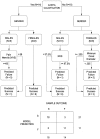A predictive model for outcome after conservative decompression surgery for lumbar spinal stenosis
- PMID: 14658061
- PMCID: PMC3468041
- DOI: 10.1007/s00586-003-0583-2
A predictive model for outcome after conservative decompression surgery for lumbar spinal stenosis
Abstract
This study was designed to develop predictive models for surgical outcome based on information available prior to lumbar stenosis surgery. Forty patients underwent decompressive laminarthrectomy. Preop and 1-year postop evaluation included Waddell's nonorganic signs, CT scan, Waddell disability index, Oswestry low back pain disability questionnaire, low back outcome score (LBOS), visual analog scale (VAS) for pain intensity, and trunk strength testing. Statistical comparisons of data used adjusted error rates within families of predictors. Mathematical models were developed to predict outcome success using stepwise logistic regression and decision-tree methodologies (chi-squared automatic interaction detection, or CHAID). Successful outcome was defined as improvement in at least three of four criteria: VAS, LBOS, and reductions in claudication and leg pain. Exact logistic regression analysis resulted in a three-predictor model. This model was more accurate in predicting unsuccessful outcome (negative predictive value 75.0%) than in successful outcome (positive predictive value 69.6%). A CHAID model correctly classified 90.1% of successful outcomes (positive predictive value 85.7%, negative predictive value 100%). The use of conservative surgical decompression for lumbar stenosis can be recommended, as it demonstrated a success rate similar to that of more invasive techniques. Given its physiologic and biomechanical advantages, it can be recommended as the surgical method of choice in this indication. Underlying subclinical vascular factors may be involved in the complaints of spinal stenosis patients. Those factors should be investigated more thoroughly, as they may account for some of the failures of surgical relief. The CHAID decision tree appears to be a novel and useful tool for predicting the results of spinal stenosis surgery
Figures
Similar articles
-
Clinical and psychofunctional measures of conservative decompression surgery for lumbar spinal stenosis: a prospective cohort study.Eur Spine J. 2003 Apr;12(2):197-204. doi: 10.1007/s00586-002-0479-6. Epub 2002 Nov 30. Eur Spine J. 2003. PMID: 12709858 Free PMC article.
-
A decision tree analysis to predict clinical outcome of minimally invasive lumbar decompression surgery for lumbar spinal stenosis with and without coexisting spondylolisthesis and scoliosis.Spine J. 2023 Jul;23(7):973-981. doi: 10.1016/j.spinee.2023.01.023. Epub 2023 Feb 4. Spine J. 2023. PMID: 36739978
-
Minimum 10-year outcome of decompressive laminectomy for degenerative lumbar spinal stenosis.Spine (Phila Pa 1976). 2000 Jul 15;25(14):1754-9. doi: 10.1097/00007632-200007150-00003. Spine (Phila Pa 1976). 2000. PMID: 10888941
-
Comparison of clinical and radiological outcomes of full-endoscopic versus microscopic lumbar decompression laminectomy for the treatment of lumbar spinal stenosis: a systematic review and meta-analysis.Ann Palliat Med. 2021 Oct;10(10):10130-10146. doi: 10.21037/apm-21-198. Epub 2021 Sep 15. Ann Palliat Med. 2021. PMID: 34551575
-
Efficacy and Safety of Full-endoscopic Decompression via Interlaminar Approach for Central or Lateral Recess Spinal Stenosis of the Lumbar Spine: A Meta-analysis.Spine (Phila Pa 1976). 2018 Dec 15;43(24):1756-1764. doi: 10.1097/BRS.0000000000002708. Spine (Phila Pa 1976). 2018. PMID: 29794584 Review.
Cited by
-
Degenerative Spinal Stenosis and Ipsi-Contralateral Decompression: Presentation of a Surgical Technique and Clinical Cases.Cureus. 2024 Jul 30;16(7):e65737. doi: 10.7759/cureus.65737. eCollection 2024 Jul. Cureus. 2024. PMID: 39211656 Free PMC article.
-
Patient-based outcomes for the operative treatment of degenerative lumbar spinal stenosis.Eur Spine J. 2006 Nov;15(11):1661-9. doi: 10.1007/s00586-005-0033-4. Epub 2005 Dec 21. Eur Spine J. 2006. PMID: 16369827
-
Predictive modeling of complications.Curr Rev Musculoskelet Med. 2016 Sep;9(3):333-7. doi: 10.1007/s12178-016-9354-7. Curr Rev Musculoskelet Med. 2016. PMID: 27286683 Free PMC article. Review.
-
Gender differences as an influence on patients' satisfaction rates in spinal surgery of elderly patients.Eur Spine J. 2005 Dec;14(10):1027-32. doi: 10.1007/s00586-004-0808-z. Epub 2005 May 24. Eur Spine J. 2005. PMID: 15912353
-
An Outcome Measure of Functionality and Pain in Patients with Low Back Disorder: A Validation Study of the Iranian version of Low Back Outcome Score.Asian Spine J. 2016 Aug;10(4):719-27. doi: 10.4184/asj.2016.10.4.719. Epub 2016 Aug 16. Asian Spine J. 2016. PMID: 27559453 Free PMC article.
References
Publication types
MeSH terms
LinkOut - more resources
Full Text Sources
Medical


